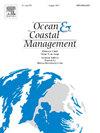A multi-criteria decision-making model for sustainable selection of coastal protection structures
IF 4.8
2区 环境科学与生态学
Q1 OCEANOGRAPHY
引用次数: 0
Abstract
Although nature-based and hybrid (i.e., a combination of hard and nature-based) solutions provide well-documented benefits to both the environment and people living nearby, they cannot be implemented in all coastal zones. Thus, the selection process of coastal protection structures (CPSs) requires an in-depth and comprehensible assessment with an effective and robust decision-support framework. Existing frameworks in the literature, however, do not focus on the selection of nature-based solutions and environmental and social factors were not considered thoroughly in these frameworks. In this respect, this research aims to develop a decision-support model that guides decision-makers in selecting the most appropriate and sustainable CPSs. The framework was designed in a way that includes a variety of environmental and social factors along with economic and technical aspects. Then, fuzzy AHP and TOPSIS analyses were conducted to determine the relative importance of the selection factors and to select the most appropriate CPS. Factors such as sediment dynamics, geotechnical issues, construction cost, transportation and navigation effects, and technological know-how were among the top-rated factors. TOPSIS analysis results revealed that mangrove forests and artificial reefs were the top two most sustainable CPSs. The proposed framework can minimize the social and environmental impacts of CPSs and expedite the green transition in the coastal environment.
可持续选择海岸保护结构的多标准决策模型
虽然以自然为基础的解决方案和混合解决方案(即硬性和自然相结合的解决方 案)为环境和附近居民带来了有据可查的好处,但它们不可能在所有沿岸地区实施。因此,在选择海岸保护结构(CPS)的过程中,需要通过有效和强大的决策支持框架进行深入和全面的评估。然而,文献中的现有框架并不关注基于自然的解决方案的选择,而且这些框架也没 有全面考虑环境和社会因素。为此,本研究旨在开发一个决策支持模型,指导决策者选择最合适、最可持续的 CPS。该框架的设计方式包括各种环境和社会因素以及经济和技术方面。然后,进行模糊 AHP 和 TOPSIS 分析,以确定选择因素的相对重要性,并选择最合适的 CPS。沉积物动力学、岩土工程问题、建筑成本、运输和航行影响以及技术诀窍等因素被列为最重要的因素。TOPSIS 分析结果显示,红树林和人工鱼礁是最具可持续发展性的 CPS 的前两名。建议的框架可以最大限度地减少 CPS 对社会和环境的影响,加快沿海环境的绿色转型。
本文章由计算机程序翻译,如有差异,请以英文原文为准。
求助全文
约1分钟内获得全文
求助全文
来源期刊

Ocean & Coastal Management
环境科学-海洋学
CiteScore
8.50
自引率
15.20%
发文量
321
审稿时长
60 days
期刊介绍:
Ocean & Coastal Management is the leading international journal dedicated to the study of all aspects of ocean and coastal management from the global to local levels.
We publish rigorously peer-reviewed manuscripts from all disciplines, and inter-/trans-disciplinary and co-designed research, but all submissions must make clear the relevance to management and/or governance issues relevant to the sustainable development and conservation of oceans and coasts.
Comparative studies (from sub-national to trans-national cases, and other management / policy arenas) are encouraged, as are studies that critically assess current management practices and governance approaches. Submissions involving robust analysis, development of theory, and improvement of management practice are especially welcome.
 求助内容:
求助内容: 应助结果提醒方式:
应助结果提醒方式:


